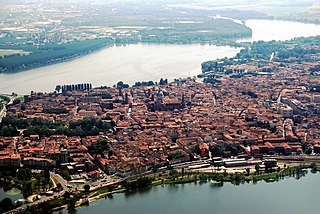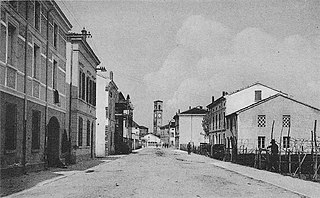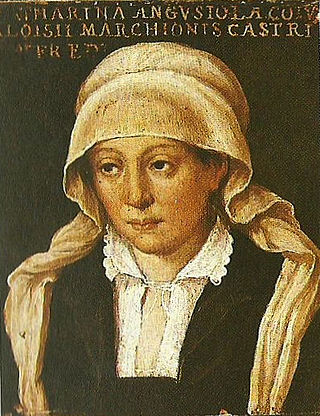
Mantua is a comune (municipality) in the Italian region of Lombardy, and capital of the province of the same name.

The province of Mantua is a province in the Lombardy region of Italy. Its capital is the city of Mantua. It is bordered to the north-east by the province of Verona, to the east by the province of Rovigo, to the south by the province of Ferrara, province of Modena, province of Reggio Emilia and province of Parma, to the west by the province of Cremona and to the north-west by the province of Brescia.
Besides Milan, the region of Lombardy has 10 other provinces, each named for the largest city and capital of the respective province: Bergamo, Brescia, Como, Cremona, Lecco, Lodi, Mantova, Pavia, Sondrio, and Varese. Musically, they offer:

Gazoldo degli Ippoliti is a comune (municipality) in the Province of Mantua in the Italian region Lombardy, located about 110 kilometres (68 mi) east of Milan and about 15 kilometres (9 mi) west of Mantua.

Quistello is a comune (municipality) in the Province of Mantua in the Italian region Lombardy, located about 150 kilometres (93 mi) southeast of Milan and about 20 kilometres (12 mi) southeast of Mantua.

San Giacomo delle Segnate is a comune (municipality) in the Province of Mantua in the Italian region Lombardy, located about 160 kilometres (99 mi) southeast of Milan and about 30 kilometres (19 mi) southeast of Mantua.

San Giovanni del Dosso is a comune (municipality) in the Province of Mantua in the Italian region Lombardy, located about 160 kilometres (99 mi) southeast of Milan and about 30 kilometres (19 mi) southeast of Mantua.

The Diocese of Mantua is a Latin Church ecclesiastical territory or diocese of the Catholic Church in Italy. The diocese existed at the beginning of the 8th century, though the earliest attested bishop is Laiulfus (827). It has been a suffragan of the Archdiocese of Milan since 1819.
San Giacomo may refer to the following:

Frans Geffels, known in Italy as Francesco Geffels, was a Flemish painter, printmaker, architect, stage designer and designer of ephemeral structures for solemn and festive occasions. After training in his native Antwerp, he was mainly active in Mantua, where he was prefetto delle fabbriche to the Duke, a role that gave him the direction of the artistic and construction activities undertaken by the Ducal court. He worked also on projects for the local aristocratic class of Mantua. In addition, he completed projects for the Liechtenstein princes and for the imperial court in Vienna.

The church of San Martino, dedicated to St Martin of Tours is a Baroque architecture, Roman Catholic church located on Via Pomponazzo in a quartiere once known as San Martino in Mantua, region of Lombardy, Italy.
The following is a timeline of the history of the city of Mantua in the Lombardy region of Italy.
Giorgio Andreasi (1467–1549) was a Roman Catholic prelate who served as Bishop of Reggio Emilia (1544–1549), Apostolic Nuncio to Venice (1540–1542), and Bishop of Chiusi (1538–1544).

Campanino, also known as mela modenese, transl. Modenese apple, or mela della nonna, transl. grandmother's apple, is a variety of the domestic apple. Thanks to its long shelf life, the Campanino has been popular not only in Italy but also in export to countries such as Germany.

Castel Goffredo Town Hall and Loggia della Magnifica Comunità are located in Piazza Mazzini in Castel Goffredo, in the Province of Mantua (Italy). It is the seat of the municipality.

The history of Castel Goffredo, an Italian municipality located in Upper Mantua on the border with the province of Brescia, began in the first half of the 3rd millennium B.C., although the present town was founded in Roman times and then developed over the following centuries. In the early medieval period the history of the city was closely linked to the control of the powerful families of the Visconti, Della Scala and the Republic of Venice. However, the city's history remains inextricably linked to the Gonzaga, who ruled it for 400 years. An autonomous fief from 1444 to 1602 under the first marquis Alessandro Gonzaga, it was at this town, in 1511 with Aloisio Gonzaga, that the collateral branches of the "Gonzaga of Castel Goffredo, Castiglione and Solferino" and the minor branch of the "Gonzaga of Castel Goffredo" originated, which died out in 1593. Castel Goffredo became one of the historic Gonzaga capitals, the forerunner of other small capitals from Castiglione to Sabbioneta, due to its urban layout of 1480, equipped with a strict orthogonal grid. With the advent of Napoleon, the town was part of the Cisalpine Republic and, after its fall, of the Kingdom of Lombardy-Venetia; in 1861 it was finally united to the Kingdom of Italy, following its subsequent historical events.

Castelvecchio is the ancient fortified village of Castel Goffredo, in the province of Mantua Lombardy region in Italy, surrounded by walls and a moat. The boundaries currently correspond to the garden of the Palazzo Gonzaga-Acerbi to the north, to vicolo Remoto and vicolo Cannone to the east, to Piazza Mazzini to the south and to piazzetta Castelvecchio and vicolo Castelvecchio to the west.

Mantuan cuisine is the set of traditional dishes of the Italian province of Mantua, some of which date back to the time of the Gonzaga.

Caterina Anguissola Trivulzio was an Italian noblewoman.

Upper Mantua is a geographical area located northwest of the city of Mantua in the province of the same name and bordering the provinces of Brescia and Verona, bordered to the north by the morainic hills of Lake Garda, to the east by the province of Verona, to the northwest by the province of Brescia, and to the south by the plains of Middle Mantua.

















